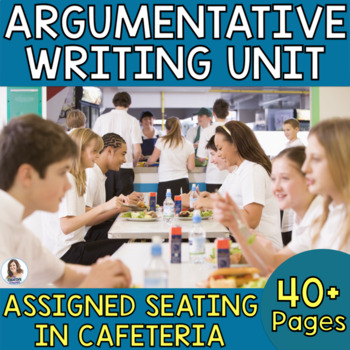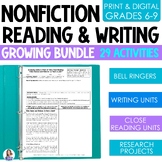Argumentative Writing - Argumentative Essay - Assigned Seating in the Cafeteria
- Zip
Also included in
- Are you looking for a variety of middle school ELA nonfiction resources that contain engaging, rigorous, and differentiated materials? This non-fiction reading comprehension bundle contains 29 individual units and lessons, including close reading units, argumentative writing units, seasonal ELA bellPrice $89.99Original Price $136.88Save $46.89
- ⇨⇨⇨Product #1- Common Core News Debate: Mandatory Drug Testing for Students⇦⇦⇦✏✏✏✏✏✏✏✏✏✏✏✏✏✏✏✏✏✏✏✏✏✏✏✏✏✏✏✏✏✏✏✏✏✏✏✏✏✏✏⇨⇨⇨Product #2- School Uniforms Debate: Real World Argumentative Writing Performance Task⇦⇦⇦This Common Core aligned resource is the perfect way to teach your students how to compose aPrice $39.99Original Price $57.99Save $18.00
Description
This Common Core unit centers around a Non Fiction article about assigned seating in the cafeteria. It includes several different activities, including an intervention writing activity for students who struggle to pick a side of the debate and support it with evidence from the text. All files comes in Microsoft Word or Powerpoint, iWork Pages or Keynotes, and PDF versions.
The following files are included in this unit:
1. Brief Outline of the Unit
2. Smartboard Presentation: This presentation includes learning objectives, warm up questions/activities, teacher models, and all other important information needed to present this unit to students.
3. "Food for Thought" Non Fiction Article-Students will read this article to gather evidence for this unit.
4. "Food for Thought" Guided Reading Worksheet: This worksheet contains a Pre-reading, During Reading, and After Reading activities along with teacher model.
5. Food for Thought Peer Assessment: This peer assessment guide can be used to have students evaluate each others' response to the After Reading Activity on the guided reading Worksheet.
6. PEEL Pre-writing Strategy Intervention: This intervention was planned for students who struggle to decide a position and support it with evidence. A teacher model using the article "You Danger" has been included in this file. This strategy works well with lower performing students.
7. Food for Thought Cover Sheet: This worksheet contains all the essential information and criteria that students will need to complete the Letter to a Principal extended writing activity.
8. PEEL Four Square Organizer: Students will use this organizer to brainstorm and organize their thoughts for their letter. A teacher model using school uniforms has been included.
9. Self and Peer Assessment Guide: Students will use this assessment guide to self and peer assess letters. The guide includes a checklist and TAG review for students to give each other high quality academic feedback.
10. Writing Guiding Questions Bookmarks- This file contains guiding questions in the form of a bookmark. Students can use this to guide them in the writing process.
▶️ Connect with The Creative Classroom:
➜ Sign up HERE for The Creative Classroom's EMAIL LIST for exclusive freebies, tips, and more!
➜ BLOG







